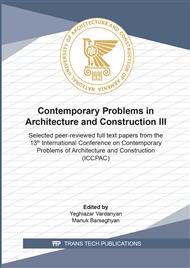[1]
R.S. Khanukaev, To the issue of plastering works for restoration of historical structures, Industrial and civil construction. 5 (2003) 33-36.
Google Scholar
[2]
YU.S. Karagulova, Ye.A. Nikolenko, S.V. Kaloshina, Traditional and alternative compositions for plastering works, Modern technologies in construction. Theory and practice. 2 (2017) 262-268.
Google Scholar
[3]
V.G. Batrakov, Modified concrete, ACB, Moscow, (2002).
Google Scholar
[4]
Yu.M. Bazhenov, B.C. Demyanova, V.I. Kalashnikov, D32 Modified high quality concrete, Scientific edition. Publishing house of the Association of building universities, Moscow, (2006).
Google Scholar
[5]
H.H. Qaramyan, G.G. Manukyan, V.P. Toroyan, V.R. Harutyunyan, N.B. Knyazyan, Inwestigation of composition of plasters of the Surb Hovhannes (Surb Sargis) church in Meghri, NPUA proceedings chemical and environmental technologies. 2 (2018) 78-85.
Google Scholar
[6]
S.A. Dergunov, S.A. Orekhov, Dry building mixtures (composition, technology, properties): Textbook for SPE, Vocational Education, Orenburg State University, (2020).
Google Scholar
[7]
K.I. Lvovich, Sand concrete and its use in construction, Publishing house LLC Stroy - Beton,, St. Petersburg, (2007).
Google Scholar
[8]
V.V. Kozlov, Dry construction mixtures: Textbook, ACB, Moscow, (2000).
Google Scholar
[9]
Dvorkin LI Building material science. Russian-English reference book: study guide / Moscow; Vologda: Infra-Engineering, 2020 -652p.
Google Scholar
[10]
N.A. Melikyan, V.M. Arutyunyan, Restoration of architectural monuments, Century,Yerevan, (2003).
Google Scholar
[11]
Harutyunyan V., Nalbandyan G., Grigoryan A., Restoration of architectural monuments. Yerevan, 2003.- pp.210-220.
Google Scholar
[12]
Atsagortsyan Z.A. Natural stone materials of Armenia. - Moscow: Publishing house. Architecture C, 1967 - 238 p.
Google Scholar
[13]
M.G. Altykin, R.Z. Rakhimov, G.R. Bulkai et al., On mechanism of gypsum structural transformations during thermal treatment, University Proceedings. Construction. 12 (1994) 59-64.
Google Scholar
[14]
V.N. Smirenskaya, S.A. Antipina, S.N. Sokolova, Chemical technology of binding materials, Publishing House of Tomsk Polytechnic University, Tomsk, (2009).
Google Scholar
[15]
Butt Yu.M., Sychev M.M., Timashev V.V., Chemical technology of binders. M., Higher School, 1980.- 472p.
Google Scholar
[16]
Shmitko E.I., Krylova A.V., Shatalova V.V., Chemistry of cement and binders: study pos. Voronezh, 2005.-164p.
Google Scholar
[17]
M.I. Kuzmenkov, O.E. Khotyanovich, Chemical technology of binding substances, study. pos. Belarusian State Technological University,, Minsk 2008.-277p.
Google Scholar
[18]
M.Ya. Bakbau, Atomic structure and transformation mechanism of calcium silicates, Cement and its application. 4 (2006) 71-76.
Google Scholar
[19]
Ar.A. Arzumanyan, M.M. Badalyan, A.K. Karapetyan, E.R. Sahakyan, Av.A. Arzumanyan, H.S. Gevorgyan, Investigation Methods of Physical-Meshanical Characteristics of Building Productts, Educational and practical manual 2, Yerevan, (2017).
Google Scholar


